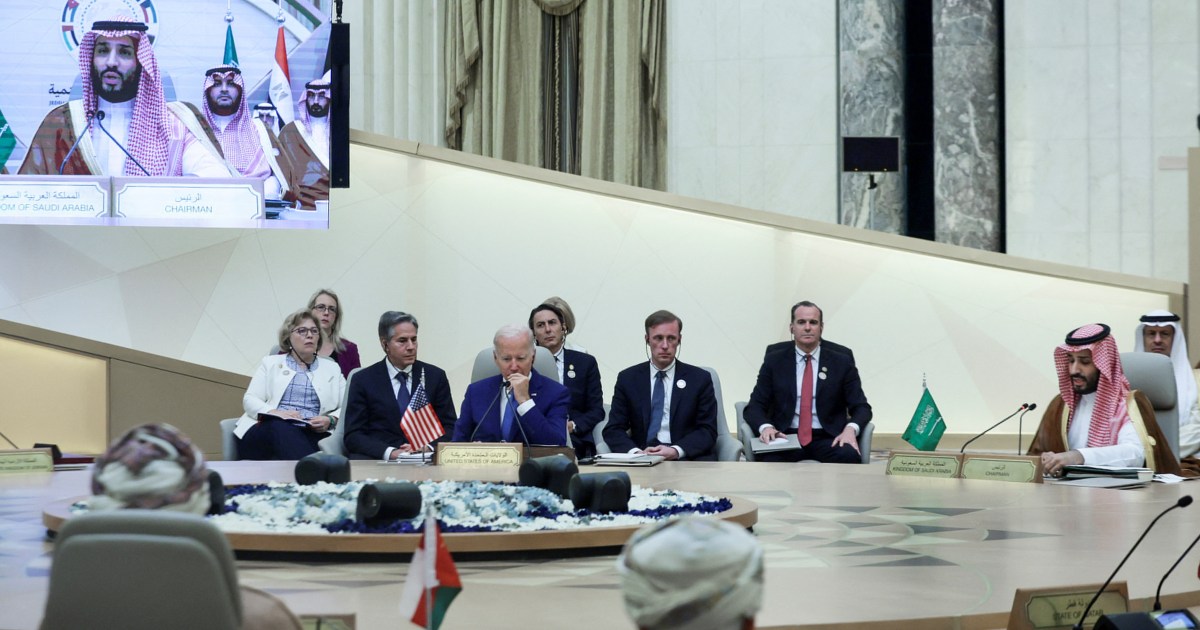U.S. President Joe Biden’s meeting with Saudi Arabia’s Crown Prince Mohammed bin Salman has been widely described as a retreat from his intent to restore a foreign policy anchored in a commitment to democracy, human rights, and the rule of law. While the White House insists that its support for a values-based foreign policy has not been compromised, the realist turn in Biden’s approach to the Middle East has been welcomed by some as a necessary corrective, including, apparently, by senior officials in Biden’s National Security Council.
However, downgrading the importance the United States attaches to human rights in the Middle East carries far greater costs, in both the short and the longer term, than such assessments suggest. Assigning human rights in the Middle East to the values side — the expendable side — of the foreign policy ledger is a troubling bit of historical amnesia that carries significant potential consequences.
How the Middle East’s Arab regimes govern is a matter of singular importance to the U.S. and to the West more broadly. Despite public and official fatigue with a region that has come to be seen as a drain on U.S. resources, it is a matter of U.S. interest that we neglect to our peril. Rights abuses should be understood as the canary in the governance coal mine, a critical indicator of deeper dysfunctions that have a direct bearing on social stability and the likelihood of domestic turmoil.
When the U.S. signals that it is prepared to do business as usual despite the poor track record of Arab regimes on human rights, what Arab autocrats hear is that they too can pursue business as usual — not only with respect to rights but in how they manage domestic politics more broadly. They hear a familiar and welcome refrain: that the U.S. again prioritizes stability over reforms that might upset an autocratic status quo. Yet as former presidents understood, U.S. support for Arab autocrats in the interest of stability and security produced neither. Instead, it enabled corrupt, repressive rulers and their cronies who enriched themselves at the expense of their people and failed to address the systemic erosion of social and economic conditions that weakened middle classes and left tens of millions of young people without hope for the future. Ultimately, failures of governance by Arab regimes sparked the largest wave of mass protests in the region’s history — the Arab Spring of 2011.
In the decade since, the conditions that led to uprisings in 2011 have only gotten worse. Lebanon’s economy has collapsed. Tunisia’s fragile democracy is unraveling. In the cases of Libya, Syria, and Yemen, the conflicts that followed mass protests continue to fester, immiserating millions and causing the massive refugee flows that destabilized European politics and empowered right-wing nativist movements in Hungary, Poland, the United Kingdom, France, and Denmark. The U.S. has provided more than $15 billion in humanitarian support for Syria alone. A second wave of mass protests in 2019 in Iraq, Lebanon, Algeria, and Sudan ended with little to show for itself. Yet renewed protests underscored yet again the depth of popular anger with regimes and just how quickly superficial stability can collapse. In response, Arab regimes have become even more repressive since 2011, including those that participated in the regional summit arranged for Biden’s trip. Collectively, poverty, corruption, inequality, and repression have been described as a “structural threat” to the Arab region, more so than the realist concerns that motivated Biden’s overtures to Saudi Arabia.
If we ever imagined that the consequences of failed governance could be contained, the 2011 uprisings and their aftermath, including the emergence of the Islamic State group, should have put paid to that idea. What happens in the Middle East all too rarely stays in the Middle East. There is little question that European Union member states and the U.S. would be subject to spillover should another region-wide wave of mass protests and insurgencies occur. Nor would upheaval on this scale be the only circumstance in which the effects of failed autocratic rule become relevant for the U.S. and EU. Across the Middle East, even in the wealthiest Gulf states, youth unemployment remains disturbingly high. In a recent report, the World Bank referred to “crippling joblessness” as a leading driver of social distress in the region and identified regime failures as its principal cause. Not surprisingly, as the most recent data from the Arab Barometer survey project shows, significant numbers of Arab citizens report that they have considered emigrating, even as opportunities for legal entry into the EU or U.S. have sharply narrowed.

Anticipating criticism of his Saudi visit, Biden himself wrote in a Washington Post op-ed that the trip offered an opportunity to raise human rights and the murder of Post journalist Jamal Khashoggi directly with the Saudi crown prince. Had the visit not been choregraphed to minimize these concerns, such statements would be more compelling. As it becomes clear how little the U.S., or Biden himself, gained from the Saudi visit, the costs of undermining what was to be a pillar of his foreign policy will become more apparent. At a moment when failures of autocracy are on vivid display in Russia, China, Iran, and elsewhere, the Biden administration now faces an uphill battle to regain its credibility as an advocate of democracy, especially in the Middle East. At a minimum, the administration must do more than talk the talk of rights and democracy. It must also walk the walk in how it engages with Arab autocrats — including when it might be politically expedient to bump fists. To do so may well involve tradeoffs, anger Arab rulers, and incur costs to the U.S. But the failure to do so enables dysfunctional, repressive regimes and increases the odds that the U.S. will pay a far higher price in the future.


